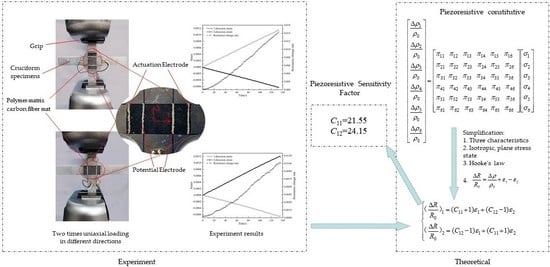Two-Dimensional Piezoresistive Response and Measurement of Sensitivity Factor of Polymer-Matrix Carbon Fiber Mat
Abstract
:1. Introduction
2. Theory of Piezoresistive Model
- (1)
- It is impossible for shear stress to produce positive piezoresistive effect,
- (2)
- Normal stress cannot produce shear piezoresistive effect,
- (3)
- Shear stress can only produce piezoresistive effect in the plane which acts on,
3. Experimental Research
3.1. Raw Material
3.2. Specimens Preparation
3.3. The Experimental Process
4. Results and Discussion
4.1. Experimental Results
4.2. Solution of Piezoresistivity Sensitivity Factor
4.3. Piezoresistive Constitutive Verification
5. Conclusions
- (1)
- Based on piezoresistance theory, the constitutive model of the polymer-matrix carbon fiber mat under plane stress state was deduced in this paper, and the response law of its resistance under bidirectional strains was investigated. Combined with the experimental results, the piezoresistance sensitivity factor of the polymer-matrix carbon fiber mat was obtained, and the piezoresistance constitutive relationship in the orthogonal strain state was established. The rationality of the piezoresistance relationship was verified by comparing it with the experimental results.
- (2)
- In this study, the shear piezoresistance sensitivity factor of the carbon fiber mat could not be measured. Therefore, further research is needed in the future.
Author Contributions
Funding
Acknowledgments
Conflicts of Interest
References
- Kalashnyk, N.; Faulques, E.; Schjødt-Thomsen, J.; Jensen, L.R.; Rauhe, J.C.M.; Pyrz, R. Strain Sensing in Single Carbon Fiber Epoxy Composites by Simultaneous in-situ Raman and Piezoresistance Measurements. Carbon 2016, 109, 124–130. [Google Scholar] [CrossRef]
- Kalashnyk, N.; Faulques, E.; Schjødt-Thomsen, J.; Jensen, L.R.; Rauhe, J.C.M.; Pyrz, R. Monitoring Self-sensing Damage of Multiple Carbon Fiber Composites Using Piezoresistivity. Synth. Met. 2017, 224, 56–62. [Google Scholar] [CrossRef]
- Tang, J.; Zhu, S.R.; Li, Z.Q. Experimental Research on Piezoresistivity of Continuous Carbon Fiber Prepreg Sensitive Layer. J. Wuhan Univ. Technol. 2010, 32, 16–19. [Google Scholar]
- Vavouliotis, A.; Paipetis, A.; Kostopoulos, V. On the fatigue life prediction of CFRP laminates using the Electrical Resistance Change method. Compos. Sci. Technol. 2011, 71, 630–642. [Google Scholar] [CrossRef] [Green Version]
- Todoroki, A.; Haruyama, D.; Mizutani, Y.; Suzuki, Y.; Yasuoka, T. Electrical Resistance Change of Carbon/Epoxy Composite Laminates under Cyclic Loading under Damage Initiation Limit. J. Compos. Mater. 2014, 4, 22–31. [Google Scholar] [CrossRef] [Green Version]
- Chen, J.F.; Morozov, E.V.; Shankar, K. Progressive failure analysis of perforated aluminium/CFRP fibre metal laminates using a combined elastoplastic damage model and including delamination effects. Compos. Struct. 2014, 114, 64–79. [Google Scholar] [CrossRef]
- Takahashi, K.; Todoroki, A.; Matsuzaki, R. Simultaneous Measurement of Multiple Electrical Resistance Changes with Strain of CFRP. J. Solid Mech. Mater. Eng. 2010, 4, 557–567. [Google Scholar] [CrossRef]
- Bontea, D.M.; Chung, D.D.L.; Lee, G.C. Damage in carbon fiber-reinforced concrete, monitored by electrical resistance measurement. Cem. Concr. Res. 2000, 30, 651–659. [Google Scholar] [CrossRef]
- Zheng, L.X. Research on Electric Conductivity and Sensing Characteristic of Smart Concrete. Ph.D. Thesis, Wuhan University of Technology, Wuhan, China, 2011. [Google Scholar]
- Wang, L.; Deng, Y.S.; Duan, B.Z. Crack Detection for Composite Plate under Cyclic Loading by Carbon Fiber Smart Layers. Technol. Eng. Sci. 2018, 18, 295–299. [Google Scholar]
- Huang, J.J.; Liu, R.G.; Xu, Z.H.; Xie, G.H. Study on the Engineering Application of the Sensor Based on the Piezo-resistance Effect of CFRP. Fiber Reinf. Plast. Compos. 2017, 9, 46–51. [Google Scholar]
- Liang, G.; Liu, R.G.; Xu, Z.H.; Xie, G.H.; Huang, J.J. Experimental Study on the Sensing Characteristics of CFRP Tendons Based on the Piezoresistivity. Fiber Reinf. Plast. Compos. 2017, 2, 60–63. [Google Scholar]
- Zheng, H.S.; An, W.; Wu, J.W.; Zhao, Z. Piezoresistivity of polymer-matrix carbon fiber filament in plane stress state. Mater. Res. Express. 2019, 6, 085602. [Google Scholar] [CrossRef]
- Li, J. Piezoresistive Response of Polymer Matrix Carbon Fiber Smart Layer in Thin Plate Bending. Guangzhou Chem. Ind. Technol. 2014, 42, 81–82. [Google Scholar]
- Zhang, X.Y. Characteristic Research of Carbon Fiber Smart Layer and Its Field Monitoring. Ph.D. Thesis, Wuhan University of Technology, Wuhan, China, 2007. [Google Scholar]







| Name | Specification (g/m2) | Organic Matter Content (%) | Fiber Diameter (μm) | Water Content (%) |
| Parameters | 10 | 6–12 | 7.02 ± 2 | ≤0.5 |
| Groups | Longitudinal Piezoresistive Sensitivity Factor/C11 | Lateral Piezoresistive Sensitivity Factor/C12 |
|---|---|---|
| No. 1 | 23.6 | 23.3 |
| No. 2 | 19.5 | 25.0 |
| Average value | 21.55 | 24.15 |
| Loading Direction | ε1 × (10−6) | ε2 × (10−6) | Error | ||
|---|---|---|---|---|---|
| 1-direction | 1186.1 | −618.1 | 0.0126036 | 0.0124375 | 1.3% |
| 2-direction | −593.5 | 1071.7 | 0.0107288 | 0.0114264 | 6.1% |
Publisher’s Note: MDPI stays neutral with regard to jurisdictional claims in published maps and institutional affiliations. |
© 2020 by the authors. Licensee MDPI, Basel, Switzerland. This article is an open access article distributed under the terms and conditions of the Creative Commons Attribution (CC BY) license (http://creativecommons.org/licenses/by/4.0/).
Share and Cite
Wu, M.; Huang, L.; Zhang, X.; Chen, J.; Lv, Y. Two-Dimensional Piezoresistive Response and Measurement of Sensitivity Factor of Polymer-Matrix Carbon Fiber Mat. Polymers 2020, 12, 3072. https://doi.org/10.3390/polym12123072
Wu M, Huang L, Zhang X, Chen J, Lv Y. Two-Dimensional Piezoresistive Response and Measurement of Sensitivity Factor of Polymer-Matrix Carbon Fiber Mat. Polymers. 2020; 12(12):3072. https://doi.org/10.3390/polym12123072
Chicago/Turabian StyleWu, Min, Li Huang, Xiaoyu Zhang, Jianzhong Chen, and Yong Lv. 2020. "Two-Dimensional Piezoresistive Response and Measurement of Sensitivity Factor of Polymer-Matrix Carbon Fiber Mat" Polymers 12, no. 12: 3072. https://doi.org/10.3390/polym12123072







